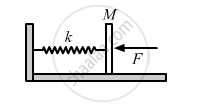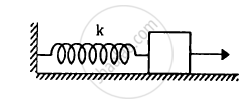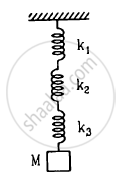Advertisements
Advertisements
Question
In following figure k = 100 N/m M = 1 kg and F = 10 N.
- Find the compression of the spring in the equilibrium position.
- A sharp blow by some external agent imparts a speed of 2 m/s to the block towards left. Find the sum of the potential energy of the spring and the kinetic energy of the block at this instant.
- Find the time period of the resulting simple harmonic motion.
- Find the amplitude.
- Write the potential energy of the spring when the block is at the left extreme.
- Write the potential energy of the spring when the block is at the right extreme.
The answer of b, e and f are different. Explain why this does not violate the principle of conservation of energy.

Solution
It is given that :
Spring constant, k = 100 N/m,
Mass of the block, M = 1 kg
Force, F = 10 N

(a) In the equilibrium position,
F = kx
where x is the compression of the spring, and
k is the spring constant.
∴ `x = F/k = 10/100`
= 0.1 m = 10 cm
(b) The blow imparts a speed of 2 ms-1 to the block, towards left.
Potential energy of spring, U = `1/2 kx^2`
Kinetic energy,
`K = 1/2 mv^2`
(c) Time period (T) is given by,
`T = 2pisqrt(M/k)`
`2pi sqrt(1/100) = pi/5` s
(d) Let A be the amplitude.
Amplitude is the distance between the mean and the extreme position.
At the extreme position, the compression of the spring will be (A + x).
As the total energy in S.H.M. remains constant, we can write:
`1/2k(A + x )^2 = 1/2kx^2 + 1/2Mv^2 + FA`
= 2.5 + 10A
∴ 50(A + 0.1)2 = 2.5 + 10A
⇒ 50A2 + 0.5 + 10A = 2.5 + 10A
⇒ 50A2 = 2
⇒ `A^2 = 2/50 = 4/100`
⇒ `A = 2/10 m = 0.2 m = 20 cm`
(e) Potential Energy at the left extreme will be,
`P.E. = 1/2k(A + x)^2`
= `1/2 xx 100 xx (0.1 + 0.2)^2`
= 50 × (0.09) = 4.5 J
(f) Potential Energy at the right extreme is calculated as:
Distance between the two extremes = 2A
`P.E. = 1/2k(A + x)^2 - F(2A)`
= 4.5 − 10(0.4) = 0.5 J
As the work is done by the external force of 10 N, different values of options (b), (e), and (f) do not violate the law of conservation of energy.
APPEARS IN
RELATED QUESTIONS
A particle executes simple harmonic motion with an amplitude of 10 cm. At what distance from the mean position are the kinetic and potential energies equal?
The equation of motion of a particle started at t = 0 is given by x = 5 sin (20t + π/3), where x is in centimetre and t in second. When does the particle
(a) first come to rest
(b) first have zero acceleration
(c) first have maximum speed?
The spring shown in figure is unstretched when a man starts pulling on the cord. The mass of the block is M. If the man exerts a constant force F, find (a) the amplitude and the time period of the motion of the block, (b) the energy stored in the spring when the block passes through the equilibrium position and (c) the kinetic energy of the block at this position.

Find the elastic potential energy stored in each spring shown in figure, when the block is in equilibrium. Also find the time period of vertical oscillation of the block.
A rectangle plate of sides a and b is suspended from a ceiling by two parallel string of length L each in Figure . The separation between the string is d. The plate is displaced slightly in its plane keeping the strings tight. Show that it will execute simple harmonic motion. Find the time period.

Find the elastic potential energy stored in each spring shown in figure when the block is in equilibrium. Also find the time period of vertical oscillation of the block.

Discuss in detail the energy in simple harmonic motion.
Show that for a particle executing simple harmonic motion.
- the average value of kinetic energy is equal to the average value of potential energy.
- average potential energy = average kinetic energy = `1/2` (total energy)
Hint: average kinetic energy = <kinetic energy> = `1/"T" int_0^"T" ("Kinetic energy") "dt"` and
average potential energy = <potential energy> = `1/"T" int_0^"T" ("Potential energy") "dt"`
When the displacement of a particle executing simple harmonic motion is half its amplitude, the ratio of its kinetic energy to potential energy is ______.
If a body is executing simple harmonic motion and its current displacements is `sqrt3/2` times the amplitude from its mean position, then the ratio between potential energy and kinetic energy is:
A body is executing simple harmonic motion with frequency ‘n’, the frequency of its potential energy is ______.
A body is performing S.H.M. Then its ______.
- average total energy per cycle is equal to its maximum kinetic energy.
- average kinetic energy per cycle is equal to half of its maximum kinetic energy.
- mean velocity over a complete cycle is equal to `2/π` times of its π maximum velocity.
- root mean square velocity is times of its maximum velocity `1/sqrt(2)`.
Draw a graph to show the variation of P.E., K.E. and total energy of a simple harmonic oscillator with displacement.
Find the displacement of a simple harmonic oscillator at which its P.E. is half of the maximum energy of the oscillator.
A mass of 2 kg is attached to the spring of spring constant 50 Nm–1. The block is pulled to a distance of 5 cm from its equilibrium position at x = 0 on a horizontal frictionless surface from rest at t = 0. Write the expression for its displacement at anytime t.
A body of mass m is attached to one end of a massless spring which is suspended vertically from a fixed point. The mass is held in hand so that the spring is neither stretched nor compressed. Suddenly the support of the hand is removed. The lowest position attained by the mass during oscillation is 4 cm below the point, where it was held in hand.
What is the amplitude of oscillation?
An object of mass 0.5 kg is executing a simple Harmonic motion. Its amplitude is 5 cm and the time period (T) is 0.2 s. What will be the potential energy of the object at an instant t = `T/4` s starting from the mean position? Assume that the initial phase of the oscillation is zero.
The total energy of a particle, executing simple harmonic motion is ______.
where x is the displacement from the mean position, hence total energy is independent of x.
